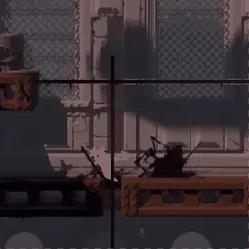
Elusive predators that lurk in the darkest regions of Rain World, spiders at first glance may not seem like much of a threat, but it's a matter of giving them a chance to see you as vulnerable prey and they won't think twice, unless may you have some light.
Like any arachnid, these creatures have a dark color that allows them to camouflage themselves in the dark. In addition, they have 8 legs that allow them to move at a faster speed than one would think. In addition, some species have tricks up their sleeves, such as a powerful paralyzer or jaws loaded with poison.
Big Spiders, also known as Wolf Spiders, are large, fast creatures with many legs and spiny backs. They are both predator and prey, and are found in dimly lit regions. Their bite is highly lethal.
Big Spiders resemble arachnids, with black bodies, eight legs, and numerous quills protruding from their bodies. Their quills and fangs fade into a brown coloration. Big Spiders' colors are affected by room darkness.
Big Spiders have a large range of vision, making it difficult to go undetected. Like all other creatures, crouching and crawling makes it less likely for Big Spiders to notice Slugcat. Big Spiders are able to hear. Rocks can be used to interest them. Additionally, Big Spiders may be distracted by other prey, such as Lantern Mice or Scavengers, which they are more interested in than Slugcat.
Big Spiders can be killed with a single Spear, but can leap over thrown objects in their line of sight. They are unable to dodge thrown objects mid-lunge. Big Spiders, like all other arthropod-like creatures, can be poisoned and killed by a Spore Puff. Additionally, Flashbangs kill Big Spiders.
Due to their cyclical fear of light; avoidance of Slugcat when holding a Lantern or Spear; and spawning in a small amount of regions, Big Spiders do not pose a large threat in campaign. Their lunges are slow and inaccurate, and can be jumped over or ducked beneath.
Big Spiders are initially afraid of prey when seeing them for the first time, triggering a 7.5 second timer before their default aggression is applied. These timers can run simultaneously and do not interrupt each other. If a Big Spider forgets the prey they are tracking, which happens anywhere between 7.5 to 45 seconds, the fear timer re-triggers.
Big Spiders shift between aggression and fear towards creatures holding a Lantern, Slugcat if they have eaten a Neuron Fly, and Lantern Mice. The duration of each phase and its intensity depends on the darkness of the given room. The darker a room is, the more frightened of light Big Spiders become. In a fully dark room, their (ShyFromLight) cycle is at its longest, spending roughly 10 seconds in one phase before switching to the other, while lighter rooms result in shorter and weaker durations of fear. It does not apply to unheld Lanterns, Lanterns that are a part of a background prop, Slugcat holding a Lantern Mouse, or room lighting. The (ShyFromLight) cycle runs independent to default relationships, and only takes priority when a Lantern becomes held.
Big Spiders possess two types of attack; a grab and a cling. When grabbing, they have a short windup and produce a rustling sound before leaping at their target. Two fangs display during a lunge attack, and are visible even in dark rooms. Although this attack has a 50% chance of lethality, Slugcat is never able to escape a Big Spider's grasp on their own, due to Big Spider bites having a stunbonus of 60, higher than the required les than 30 to retaliate with a weapon.
Their cling attack is a non-lethal, non-stunning attack that only slows Slugcat and other creatures down. Big Spiders are less likely to cling to Slugcat if they are holding a Lantern or Spear, or if they have neuron glow.
Big Spiders keep track of other Big Spiders that they see. When not actively pursuing prey, they seek out dead Big Spiders, biting and temporarily reviving them. If the revived Big Spider is below -100% health at the current moment, it's restored at a rate of 25% per second, otherwise it's at 66.67% per second. Spitter Spiders (but not the Mother Spiders) may also be revived, though their health regeneration speed is halved. If a Big Spider was fully eaten by a carnivorous Slugcat, was poisoned by a Spore Puff or a Flashbang, has drowned, currently being held by a creature, or is at below -800% health, they cannot be revived.
A Big Spider is revived once its health is restored to 100% and the revival has lasted for at least 1.5 seconds. Once revived, it will attempt to return to its original den and any stuck objects will be removed. The kill credit from the Player will not be removed, even if it successfully returns to the den; nor will killing it again result in another credited kill. If it hasn't retreated in time, after 7.5 seconds, the Big Spider will start losing health at a rate of ~28.57% per second and eventually die.
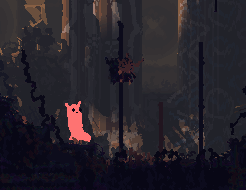
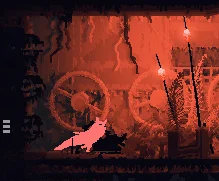
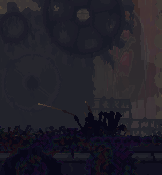
Spitter Spiders are a large, red variant of Big Spiders. They are large, spider-like creatures with many legs, retractable fangs, and spiny protrusions on their backs. Like their cousins, they are both predator and prey, though their ability to spit paralyzing darts from a distance makes them capable of hunting larger and more dangerous creatures.
Spitter Spiders resemble arachnids with black bodies, eight legs, and numerous flexible spines protruding from their bodies. Their two fangs and the longest spines fade into a red coloration that becomes black in total darkness. The darts (commonly referred to as Dart Maggots) fired from their mouths are an off-white color, and each one has an elongated sac on its end. A short time after hitting a creature, just before paralysis, these sacs appear to expand and then contract, changing colors.
Spitter Spiders take 2 Spear hits to kill, though they can be hard to hit due to their tendency to stay above Slugcat. They can be lured into areas with low ceilings where they have less space to maneuver, making them easier to hit. As with other arthropods, they are vulnerable to Spore Puffs; a single Spore Puff is sufficient to kill them.
Avoiding direct line of sight is advised to avoid getting shot. If caught in the open, the player should be always moving, as Spitter Spider shoots at where Slugcat is rather than where they will be.
If hit by a Dart Maggot, putting distance between Slugcat and the Spitter Spider may increase the chance that Slugcat can recover in time to escape. If Slugcat is too close to the Spitter Spider when paralysis sets in, they are more likely to be captured. Stabbing the Spitter Spider with a Spear before being paralyzed is feasible if the Spitter Spider is within range. Line-of-sight is important for these creatures; hiding for long enough makes them lose interest. It is best to stay on a level above or below them, but beware that they can fire darts in any direction.
If Slugcat has been captured, there is still a chance to escape before being dragged into a den since Spitter Spiders do not land death blows. Despite often being found in large groups, Spitter Spiders fight each other for prey, which may result in Slugcat being dropped.
While hunting, Spitter Spiders are more likely to avoid direct confrontation, instead preferring to crawl above their prey on ceilings, walls, and poles. They avoid close combat and instead opt to fire Dart Maggots from a distance.
They attack by spitting Dart Maggots in short bursts of three or four, which have a delayed and temporary paralyzing effect on creatures including Slugcat. Each successful hit increases the speed of the paralyzing effect on the target: getting hit by 1 dart allows for 5 seconds of normal movement before paralysis sets in, 2 darts have a 3-second delay, and 3 darts almost immediately knock out the target. Unconsciousness can last for several seconds, enough time for the Spitter Spider to approach and grab their prey.
Unlike Big Spiders, they cannot lunge; however, they attempt to hinder Slugcat by grabbing onto them if they get close enough, so they can still be dangerous in close range. If grabbed for long enough, Slugcat becomes incapacitated.


Coalescipedes, also known as Spiders, are swarming creatures that are weak on their own but capable of overpowering their prey with large numbers.
Coalescipedes are pure black in coloration. They resemble real-life spiders, having 8 legs, a fused head and thorax, and a larger abdomen. They come in various sizes and may join up with one another to form a monstrous Coalescipede chain. Coalescipedes link together from largest to smallest, with the largest at the front.
The use of Flashbangs is very effective when fighting Coalescipedes, as their flash is able to kill Coalescipede chains of any length instantly.
Coalescipedes die instantly when touching Spore Puff gas; however, Spore Puffs are not found near regions where Coalescipedes spawn.
Coalescipedes are driven away by light, meaning that they are easy to avoid if the player uses a light source such as a Lantern, Lantern Mouse or the light emitted when a Neuron Fly is consumed. Coalescipede chains can be broken up into smaller, less aggressive segments with Spears or Rocks. Throwing weapons may also cause them to release Slugcat if they have been captured. Individual Coalescipedes can be killed if hit in the center with most weapons; in chains, only the few at the front are damaged.
Individual Coalescipedes and small chains are not aggressive; they become aggressive to a creature when the total mass of the Coalescipede chain exceeds the creature's. On average, a Coalescipede chain must comprise 8 or more Coalescipedes for it to become aggressive to any Slucat or small creature.
Coalescipedes are averse to light. They become agitated and scurry away from light sources such as Lanterns, held Lantern Mice, and environmental lighting. The more intense the light is, the more agitated Coalescipedes become and the faster they run away from it. The weak glow produced by undetonated Flashbangs and Slime Mold have little to no effect on Coalescipedes. Lantern Mice, when not being held by Slugcat, barely agitate Coalescipedes with the light they produce, and Coalescipede chains hostile to them are not averse to their light whatsoever.
Coalescipedes, when hostile to a creature holding a light source, are only averse to that light for a short period of time. This period of time can vary, in some instances being nearly imperceptible and in others lasting well over 8 seconds.
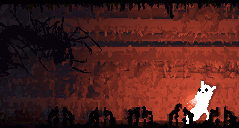

Mother Spiders are a variant of Spider. They are large, agile, and have a green coloration on the ends of their quills. When killed, they release many Coalescipedes from their body.
Mother Spiders resemble large arachnids and are similar in appearance to Big Spiders and Spitter Spiders. They possess a swollen abdomen and appear to have a head that juts out to one side. Their legs are long and slender, easily surpassing their body in height.
Despite their low speed and strength, Mother Spiders can dodge incoming attacks by leaping above or ducking. However, they are unable to dodge in quick succession, so throwing an object such as a Rock before striking it with a Spear is a viable strategy to defeat one.
When killed, the Mother Spider's abdomen releases a swarm of Coalescipedes and dull green particles. This swarm may target another creature rather than the Slugcat, giving an opportunity to escape.
Explosives can be used to kill Mother Spiders along with their Coalescipedes, although the timed fuse of Explosive Spears can allow Coalescipedes to escape before being killed.
Most of the time, Mother Spiders won't actively hunt Slugcat, instead choosing to either run away or ignore them entirely. This makes avoiding them easy, as Slugcat can just walk past them without engaging. Should the Mother Spider decide to pursue Slugcat, they are slow and can be outrun easily.
Mother Spiders are skittish, tending to avoid confrontations. They ignore Big Spiders, Spitter Spiders, and Coalescipedes. When a creature persistently follows a Mother Spider, they may resort to lunging at them to stun them. Mother Spiders can lunge at, catch, and kill Slugcat.
On death, a Mother Spider's corpse releases a dull green cloud and a swarm of Coalescipedes.
